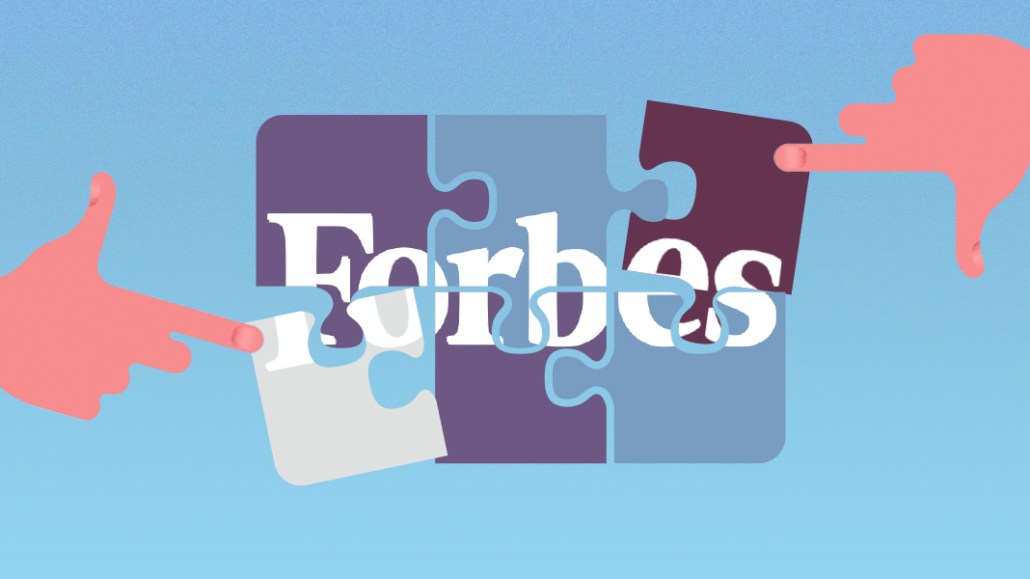‘Symptomatic of an industry in change’: How Forbes is restructuring for 2018

The past two months have been a whirlwind of change for Forbes. The 100-year-old business magazine reduced its number of print issues from 14 to 10, the New York Post reported, and it let go 20 staffers. Longtime chief product officer Lewis D’Vorkin left the company and CEO Mike Perlis left his position, replaced by editor Randall Lane and president and COO Mike Federle, respectively.
The head count will stay near its current level of 430, Forbes CRO Mark Howard said, but the company is shifting resources from print to digital products, native advertising and live events to diversify its business. (Most of those laid off were focused on print duties like sales and photo editing, according to two sources familiar with the matter.) A company spokesperson, who wouldn’t share raw numbers, said Forbes’ native ads and events businesses each grew about 30 percent year over year. Forbes hosted 17 paid events this year, up from 11 last year. In 2018, it will add at least another five events.
Forbes’ struggles aren’t unique, given the carnage that befell both traditional and digital media outlets in 2017, which has seen Time Inc. sell to Meredith Corp., Oath — the Verizon unit that contains Yahoo, AOL and HuffPost — shed jobs and digital darlings Vice Media and BuzzFeed miss their revenue goals. Media companies are finding they need to get revenue from lots of places, and ensure their content is differentiated enough to make direct connections with users.
“I would categorize Forbes’ issues as symptomatic of an industry in change,” said an ad buyer, speaking anonymously to prevent damaging business relationships with the publisher. “Their business model is under duress, and they are trying to pivot, adjust and survive like so many other publishers.”
Some of Forbes’ problems were distinct, though. The growth-hacking tactics Forbes embraced that helped digital media businesses five years ago have gone out of style. Forbes used a contributor network to forge a cheap path to scale, its site hitting 59 million unique visitors in November, according to comScore.
Multiple publishers, including HuffPost, Hearst and Bleacher Report, have cut back their contributor networks as buyers demand higher-quality content. Forbes doesn’t plan to reduce the size of its contributor network of more than 1,800 writers, Howard said.
About 80 percent of Forbes’ ad revenue comes from digital, compared to four years ago when its print and digital ad revenue were about even. But it drove digital revenue by littering its site with intrusive takeover, interstitial and autoplay ads while paginating its articles, which led it to become the publisher poster child of putting monetization ahead of user experience.
Ad position: web_incontent_pos1
That put Forbes at a disadvantage when browsers declared war on advertising, making it harder for publishers to make money off invasive ads. In September, Apple’s Safari browser began preventing third parties from tracking users for more than 24 hours after a user visited a website. And next year, Google is set to release an “ad-filtering” version of Chrome. When Google released a tool in June that let publishers see if the forthcoming version of Chrome would block their own sites’ ads, Forbes was on the list for having “failing” ads.
All this is exacerbated by the fact that as a single-title company, Forbes has no sibling publications to help shield its troubles.
Forbes is making progress. It sped up its site-load time. It cut out the interstitials and homepage takeover on its mobile site. (It kept the homepage ad on desktop but got rid of the countdown timer.) It also reduced how frequently it paginates articles, opting for an infinite scroll with most of its newly published articles. Google’s “ad experience” tool no longer lists Forbes’ ads as “failing.”
“We definitely pay close attention to how the browsers expect the UX to operate,” Howard said.
While three ad buyers expressed apathy when asked about their perception of Forbes’ brand, there are buyers who remain bullish about the publisher. Leslie Tucker, brand planner at media-buying agency The Richards Group, still sees Forbes as a premium business publisher. Tucker pointed to improved targeting of Forbes’ native — it introduced geolocation targeting to BrandVoice in February — as an example of how the legacy publisher is keeping up with the times.
Ad position: web_incontent_pos2
“The Forbes brand still has a sense of prestige. But the decisions they have made regarding their user experience, particularly putting an ad in front of the homepage, have really been a dark mark on the brand,” said Adam Kleinberg, CEO of ad agency Traction, citing research that brand marketers are becoming more critical about user experience. “It isn’t too late for them to change, but they need to be committed to it.”
More in Media

NewFronts Briefing: Samsung, Condé Nast, Roku focus presentations on new ad formats and category-specific inventory
Day two of IAB’s NewFronts featured presentations from Samsung, Condé Nast and Roku, highlighting new partnerships, ad formats and inventory, as well as new AI capabilities.

The Athletic to raise ad prices as it paces to hit 3 million newsletter subscribers
The New York Times’ sports site The Athletic is about to hit 3 million total newsletter subscribers. It plans to raise ad prices as as a result of this nearly 20% year over year increase.

NewFronts Briefing: Google, Vizio and news publishers pitch marketers with new ad offerings and range of content categories
Day one of the 2024 IAB NewFronts featured presentations from Google and Vizio, as well as a spotlight on news publishers.
Ad position: web_bfu



